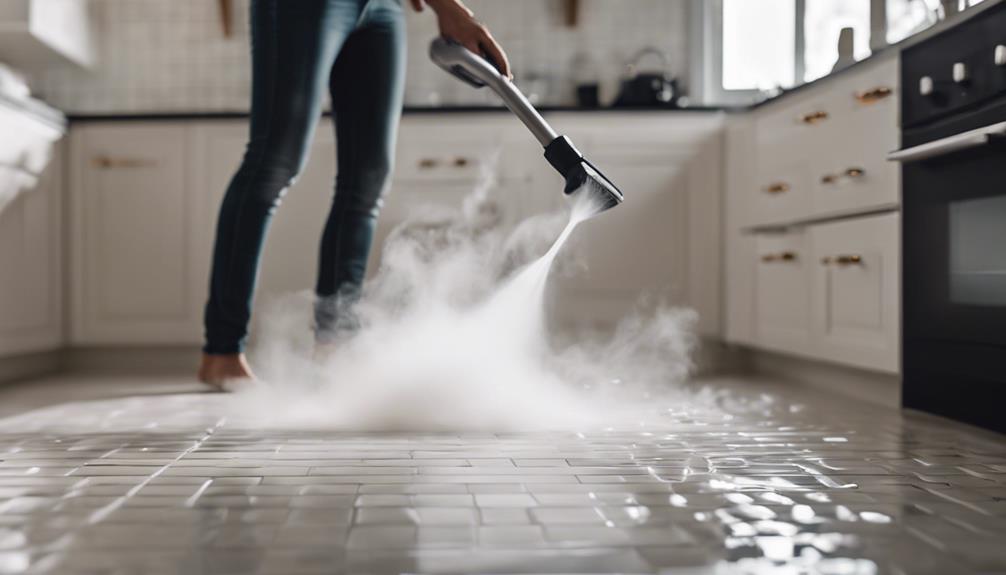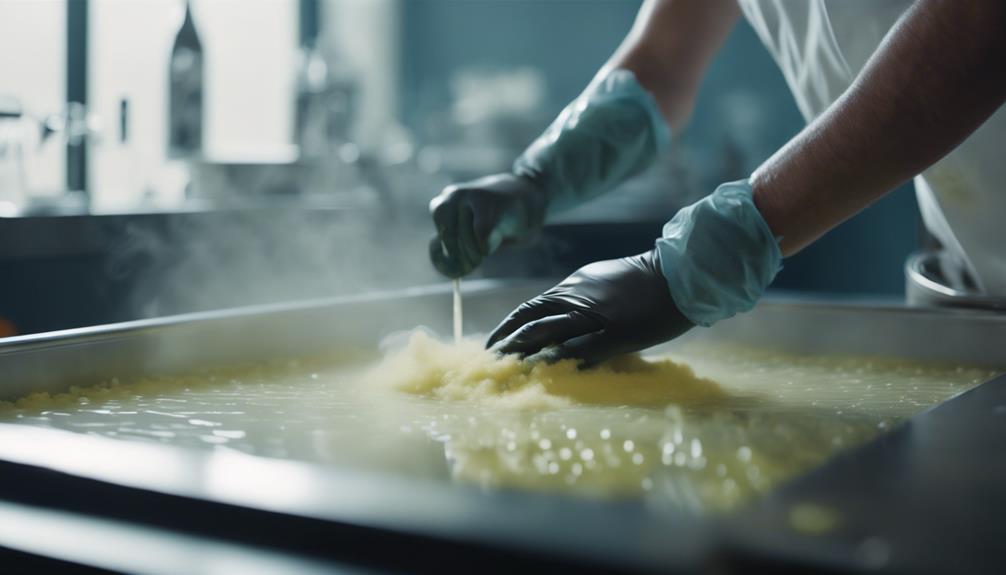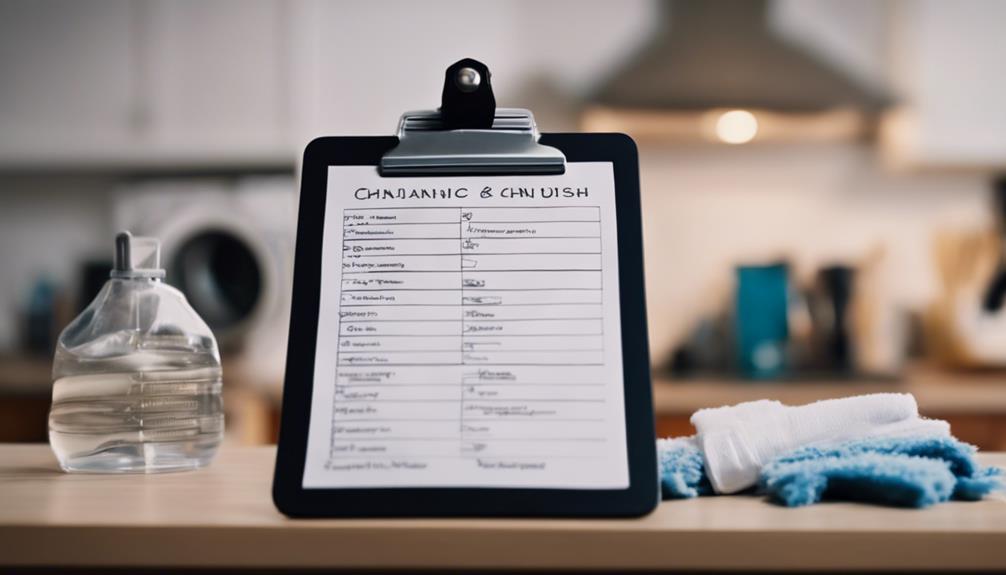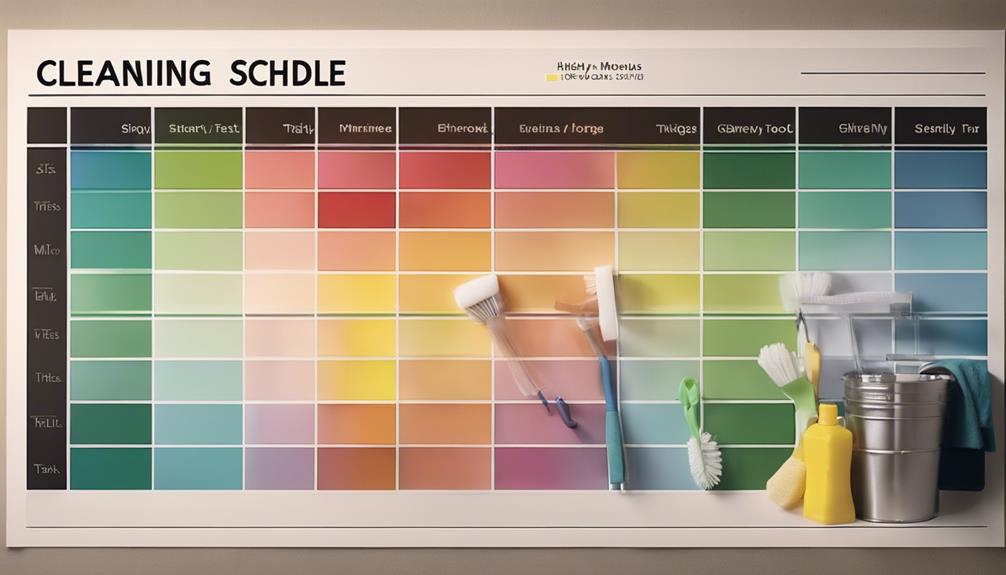When looking for the best materials for your kitchen floors with steam cleaning, opt for vinyl, ceramic, or porcelain tiles. These surfaces handle steam well, ensuring a thorough clean and germ-free kitchen environment with ease. Carefully choosing the right material guarantees compatibility with your steam mop. Remember, proper maintenance can extend the life of your kitchen floors and keep them looking new. Make your kitchen cleaning routine a breeze by selecting the ideal flooring material that works seamlessly with steam cleaning. Reveal the secrets to maintaining a spotless and hygienic kitchen effortlessly!
Key Takeaways
- Vinyl, ceramic, and porcelain are ideal for steam cleaning kitchen floors.
- These materials resist steam penetration and allow for effective cleaning.
- Steam cleaning provides deep cleaning and sanitization for these surfaces.
- Choose compatible materials to ensure successful steam mop usage.
- Proper maintenance can extend the lifespan of kitchen floors.
Benefits of Using Steam Mops
When it comes to cleaning your kitchen floors efficiently and effectively, using steam mops offers a range of benefits that make them a popular choice among homeowners. One of the key advantages of steam mops is their ability to provide deep cleaning without the need for harsh chemicals. This eco-friendly approach not only guarantees a safe environment for homes with children and pets but also eliminates the exposure to harmful substances.
Additionally, the adjustable steam settings on these mops allow you to customize the cleaning process based on the type of flooring material, ensuring thorough cleaning without causing any damage.
Moreover, steam mops offer powerful germ-killing capabilities, eradicating up to 99.9% of bacteria and germs on hard surfaces. This not only results in a cleaner and healthier home environment but also provides peace of mind.
Considerations for Kitchen Floor Materials

When selecting materials for your kitchen floor, consider the types that can withstand steam cleaning and provide easy maintenance.
Evaluate the benefits of steam cleaning for keeping your kitchen floors hygienic and free of germs.
Implement maintenance tips to guarantee the longevity and durability of your chosen kitchen floor materials.
Kitchen Floor Material Types
Selecting the appropriate kitchen floor material is essential when considering factors like durability and resistance to moisture for steam cleaning.
Tile floors, such as ceramic or porcelain, are ideal choices as they're easy to clean and sanitize, making them perfect for kitchens.
Vinyl flooring, including luxury vinyl planks or tiles, is another excellent option that can withstand steam cleaning while offering a variety of styles to match your kitchen decor.
However, laminate flooring should be avoided with steam mops due to the risk of swelling and warping from moisture exposure over time.
Natural hardwood floors aren't recommended for steam cleaning in kitchens, as the steam can damage the wood finish and cause warping.
Concrete floors, on the other hand, are a practical choice for kitchen floors, as they're durable and easy to maintain, making them suitable for steam cleaning.
When choosing a kitchen floor material, prioritize durability and resistance to moisture for effective steam cleaning results.
Steam Cleaning Benefits
Reflect on the benefits of steam cleaning in relation to different kitchen floor materials to ensure peak cleanliness and maintenance. Steam cleaning provides a safe and efficient method to clean ceramic, porcelain, and vinyl kitchen floors without the need for harsh cleaning products.
By utilizing steam mops that reach high temperatures, you can effectively eliminate tough stains, dirt, and grime while also sanitizing and eradicating germs on your kitchen floors.
When selecting a kitchen floor material, it's crucial to assess its compatibility with steam cleaning. Ceramic, porcelain, and vinyl floors are all appropriate for steam cleaning, facilitating easier and more effective maintenance.
Regular steam cleaning not only assists in keeping your kitchen floors looking pristine but also helps in preserving their hygiene over time. Embracing steam cleaning as a component of your cleaning regimen can aid you in achieving a flawless and bacteria-free kitchen environment effortlessly.
Maintenance Tips
To maintain the longevity and appearance of your kitchen floor materials, it's crucial to follow specific maintenance tips tailored to each type of flooring.
For porcelain and ceramic tiles, regular cleaning with a mild detergent and warm water is key. Avoid using abrasive cleaners that can harm the surface.
Vinyl and linoleum floors can be steam cleaned, but always check manufacturer recommendations to prevent any harm.
When it comes to wood, laminate, or natural stone floors, avoid using steam mops as the heat and moisture can result in irreversible damage. It's advisable to seal natural stone floors regularly to protect them from potential steam cleaning damage.
Compatibility With Steam Mops

When considering the compatibility of kitchen floors with steam mops, examining the materials you have is crucial. Hard surfaces such as ceramic, porcelain tile, and sheet vinyl are generally well-suited for steam cleaning.
Understanding which floor materials work best with steam mops can assist you in upholding a clean and sanitized kitchen environment.
Floor Material Compatibility
Some kitchen flooring materials are better suited for steam mops than others due to their compatibility with the heat and moisture produced during steam cleaning. Steam mops are generally safe for sealed hard surfaces like tile, ceramic, and vinyl floors. These materials can withstand the heat and moisture without being damaged.
However, it's important to avoid using steam mops on wood, laminate, waxed, or unfinished floors to prevent potential harm. The heat and moisture from steam can lead to damage and warping on these surfaces.
Before using a steam mop on your kitchen floor, always verify your flooring warranty's recommendations regarding steam cleaning. Checking the manufacturer's guidelines is vital to ensure that your floor material is compatible with steam cleaning practices.
Steam Mop Considerations
Verify the compatibility of your kitchen floor material with steam mops to guarantee effective cleaning without causing damage.
Before using a steam mop, make sure that your flooring material can withstand steam cleaning by checking with the manufacturer or installer.
Compatible materials for steam mops typically include ceramic tile, sheet vinyl, and sealed stone floors. However, it's important to avoid using steam mops on wood, laminate, waxed, or unfinished floors to prevent potential damage.
Additionally, checking the warranty of your flooring is vital to make sure that using a steam mop won't void any coverage.
Always adhere to the manufacturer's guidelines and recommendations when using a steam mop on specific floor materials to maintain the integrity and longevity of your kitchen floor.
Expert Advice on Flooring Selection

For expert advice on selecting the right kitchen flooring material compatible with steam cleaning, consult with experienced professionals in the field. These experts can provide valuable insights on the best options for your kitchen, considering factors like durability, water-resistance, and steam mop compatibility. To help you get started, here's a handy comparison table showcasing some popular kitchen flooring materials:
| Flooring Material | Durability | Water-Resistance |
|---|---|---|
| Ceramic | High | Yes |
| Porcelain | High | Yes |
| Vinyl | Moderate | Yes |
Testing and Evaluation of Steam Mops

During the evaluation of steam mops, testers conduct over 1,000 mopping strokes to assess their stain-removing capabilities.
The Good Housekeeping Institute Cleaning Lab follows industry-standard protocols established by ASTM International to ensure thorough testing.
Key criteria such as steam production, stain removal effectiveness, and overall user-friendliness are considered during these evaluations.
By rigorously testing steam mops, consumers gain valuable insights into the performance and capabilities of different models available in the market.
These tests also secure that steam mops meet quality standards and deliver the expected cleaning results on a variety of flooring surfaces.
The evaluations provide an essential resource for consumers looking to make informed decisions when selecting a steam mop for their kitchen floors.
Limitations of Steam Cleaning Kitchen Floors

When considering steam cleaning for your kitchen floors, it's essential to be aware of the specific limitations to avoid potential damage and guarantee effective cleaning. Steam mops, while great for deep cleaning and sanitizing hard surfaces in the kitchen, aren't suitable for all types of flooring. Wood, laminate, waxed, or unfinished wood surfaces shouldn't be cleaned with a steam mop as the excessive steam can lead to warping or delamination. It's important to check your kitchen flooring warranty before using a steam mop to ensure compatibility and prevent voiding the warranty.
Additionally, the seams in some kitchen floors can be vulnerable to the penetration of steam, potentially causing damage over time. While certain materials like vinyl, ceramic, and porcelain tile are better suited for steam cleaning, it's vital to exercise caution even with these surfaces to prevent any issues.
Always follow manufacturer guidelines and recommendations to maintain the integrity of your kitchen floors when using a steam mop.
Comparison With Traditional Floor Cleaning

How do steam mops differ from traditional mopping methods for cleaning kitchen floors?
When comparing steam mops to traditional mopping techniques, the benefits of steam cleaning become evident. Steam cleaning offers more power and germ-killing capabilities, surpassing traditional mopping regarding hygiene maintenance.
Additionally, steam mops provide a cost-effective solution, replacing the need for traditional floor cleaners. The all-in-one systems of steam mops, equipped with reusable or disposable pads, streamline the cleaning process, making it more efficient compared to traditional mops.
Furthermore, steam mops are neater and easier to store, reducing clutter in the kitchen that may arise from traditional mopping equipment. By ensuring a deeper and more thorough clean, steam mops eliminate the necessity for harsh chemicals on kitchen floors, setting them apart from traditional mopping methods.
Frequently Asked Questions
What Is the Best Materials for Kitchen Floors Where Steam Cleaning Is Used?
For kitchen floors where steam cleaning is used, the best materials are porcelain and ceramic tiles for durability and resistance to heat and moisture. Luxury vinyl is another suitable option due to its water-resistant properties.
What Is the Best Flooring to Use a Steam Mop On?
For using a steam mop, the best flooring options are sealed hard surfaces like ceramic, porcelain, or vinyl tile. Avoid wood, laminate, waxed, or unfinished wood floors to prevent damage. Always check manufacturer guidelines before cleaning.
What Is the Best Material to Use for a Kitchen Floor?
For your kitchen floor, consider porcelain tile or vinyl. They're durable, water-resistant, and perfect for steam cleaning. Porcelain offers diverse designs, while vinyl is budget-friendly and soft underfoot. Both are compatible with steam mops.
What Floors Should Not Be Steam Cleaned?
Avoid steam cleaning wood, laminate, waxed, and unfinished floors to prevent damage like warping, swelling, and discoloration. Some vinyl, linoleum, and cork surfaces may also be unsuitable. Prioritize checking manufacturer guidelines and using alternative cleaning methods to preserve your floors.
Conclusion
Finally, when selecting kitchen flooring, keep in mind the compatibility with steam mops to maintain the cleanliness and germ-free environment of your floors.
Expert guidance and testing are essential in discovering the most suitable material for your requirements.
Therefore, steam clean with elegance and contentment, choosing intelligent surfaces for effortless steam mopping triumph!










